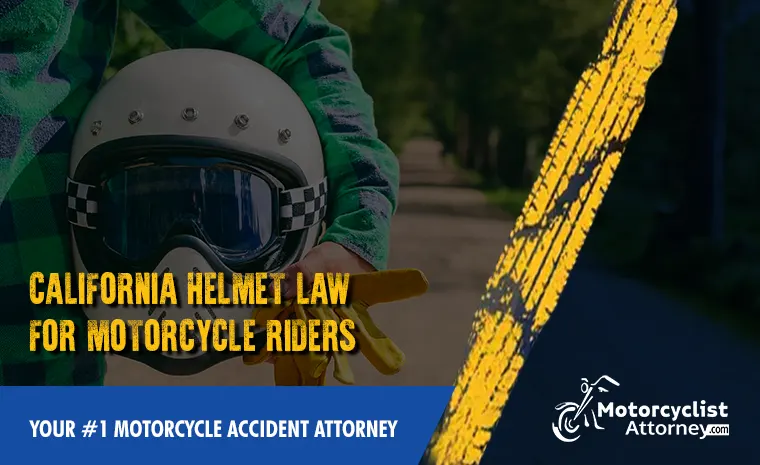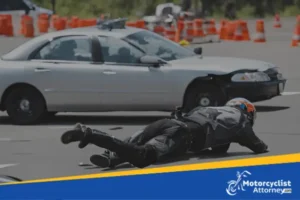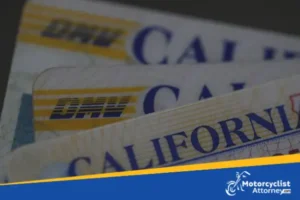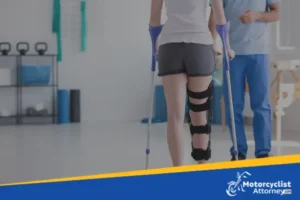California Helmet Law for Motorcycle Riders
As scary as it might sound, vehicular accidents are inevitable. Even the most careful driver would be involved in an accident if the other driver won’t make an effort when it comes to safety.
We should always take into account the rules and regulations already in place to assure that we can arrive safely at home and work.
Remember, riders and passengers are required to wear a helmet under the law. By using it, the motorcycle rider is at least safe. However, it must not be the reason to allow yourselves to be reckless and negligent on the road.
Do not forget that passengers and riders are mandated to wear a helmet, which should be a U.S. DOT compliant model, when riding a motorcycle, motor-driven cycle, or motorized bicycle. In addition, the protective gear must be certified by the manufacturer in accordance with the U.S. DOT Federal Motor Vehicle Safety Standard 218.

California Motorcycle Helmet Law History
Among any other states, California is one of those that require passengers and riders to wear a helmet. In 1992, California enacted the law that mandates helmet use by everyone.
California’s universal helmet use law took effect on January 1, 1992. Due to the implementation of the said helmet law, his use increased to 99% from about 50%.
After it was enacted, motorcycle crash fatalities throughout the state decreased by 37.5% (down from 523 deaths in 1991 to 327 in 1992). From 1991 to 1992, motorcycle death rates were reduced by 26.5%, from 70.1 per 100,000 registered motorcycles to 51.5 per 100,000.
In addition, there was also a decline in health care costs for those associated with motorcycle-related head injuries. Based on the reports, the rate of motorcyclists hospitalized for head injuries in 1993 decreased by 48% compared with 1991.
California Helmet Laws
Motorcycle helmet laws for each state in the United States differ which may be partial or universal. When we say partial law, it applies to certain groups of people including minors, inexperienced drivers, or those who don’t have adequate insurance coverage. On the other hand, universal helmet laws require all riders and passengers to wear it without exception.
California helmet law for motorcycle has a universal law that applies to all bikers, under California Vehicle Code Division 12, Chapter 5, Article 7, Section 27803.
California Vehicle Code, Section 27803 (a) states, “A driver and any passenger shall wear a safety helmet meeting requirements established pursuant to Section 27802 when riding on a motorcycle, motor-driven cycle, or motorized bicycle.”
California Vehicle Code, Section 27803 (b) states, “It is unlawful to operate a motorcycle, motor-driven cycle, or motorized bicycle if the driver or any passenger is not wearing a safety helmet as required by subdivision (a).”
California Vehicle Code, Section 27803 (c) states, “It is unlawful to ride as a passenger on a motorcycle, motor-driven cycles, or motorized bicycle if the driver or any passenger is not wearing a safety helmet as required by subdivision (a).”
California Vehicle Code, Section 27803 (d) states, “This section applies to persons who are riding on motorcycles, motor-driven cycles, or motorized bicycles operated on the highways.”
California Vehicle Code, Section 27803 (e) states, “For the purposes of this section, “wear a safety helmet” or “wearing a safety helmet” means having a safety gear meeting the requirements of Section 27802 on the person’s head that is fastened with the helmet straps and that is of a size that fits the wearing person’s head securely without excessive lateral or vertical movement.”
Apart from the vehicle codes regarding the use of motorcycle helmets, there are also laws for bicycle riders.
California Vehicle Code, Section 21212 (a) states, “A person under 18 years of age shall not operate a bicycle, a non-motorized scooter, or a skateboard, nor wear in-line or roller skates, nor ride upon a bicycle, a non-motorized scooter, or a skateboard as a passenger, upon a street, bikeway, as defined in Section 890.4 of the Streets and Highways Code, or any other public bicycle path or trail unless that person is wearing a properly fitted and fastened bicycle helmet that meets the standards of either the American Society for Testing and Materials (ASTM) or the United States Consumer Product Safety Commission (CPSC), or standards subsequently established by those entities. This requirement also applies to a person who rides upon a bicycle while in a restraining seat that is attached to the bicycle or in a trailer towed by the bicycle.”
California Vehicle Code, Section 21212 (b) states, “A helmet sold or offered for sale for use by operators and passengers of bicycles, non-motorized scooters, skateboards, or in-line or roller skates shall be conspicuously labeled in accordance with the standard described in subdivision (a), which shall constitute the manufacturer’s certification that the helmet conforms to the applicable safety standards.”
Meanwhile, there is also California motorcycle helmet visor law that requires that helmets should have a face shield and goggles or glasses which shall protect the eyes from debris, wind, and other dangers from riding a motorcycle. In addition, using protective gear with a visor will keep neck and back injuries as minimal as possible.
The Department of Motor Vehicles implemented the California motorcycle helmet visor law in 2011 which is an extension of California’s Helmet Law implemented in 1992 that requires all those riding a motorcycle or motorbike to wear a helmet.
Under this law, all riders and passengers of motorcycles must wear goggles, glasses, or a face shield that provides 100 percent coverage if their motorcycle has an open face or is riding without a windshield.
Therefore, no one can legally ride the motorcycle on public streets with any visor that does not offer 100% eye protection. It’s also not permitted to wear sunglasses on a motorcycle. In this case, the department reminds everyone that safety should be everyone’s number one priority when riding, operating, or driving a motorcycle.
To avoid vehicular collisions, one should wear a helmet for protection.
There are three main types of helmets such as half-shell, three-quarters, and full-face. Among the three, the full-face helmet has a lock-in visor which gives the best coverage and protection to the head.
Research provides that the states which implemented a universal helmet law caused the injuries and fatality rates to be reduced. As stated in the NHTSA reports, 90% of the states already enforced the universal motorcycle helmet laws, including California.
The United States Department of Transportation (DOT) sets the bar for the minimum safety standards for motorcycle manufacturers and retailers. Remember to answer the following
questions that guarantee whether or not the standard requirements have been achieved:
- Can the helmet protect the rider and passenger against collisions with large objects?
- Is it guaranteed that the helmet will still be placed on the head at critical times?
- Are the chin straps strong enough to hold the helmet in place during impact?
- What area(s) of the head does a helmet protect?
To meet the DOT minimum standards, there should be a certification sticker on it. Regardless of where you buy your motorcycle helmet, you should check for:
- The size of the helmet. It is important that the helmet fits comfortably around the head for maximum protection.
- The strap. It must fit around the ear and under the chin.
- The fitting of the helmet. Wear it on your forehead, just above the eyebrows.
- The Sticker. It is mandatory that the helmets have the stickers approved by DOT which indicate that the manufacturer met the safety standards for a motorcycle helmet.
Check your helmets regularly to keep yourself safe. However, in case you have been involved in a motorcycle accident due to the defect of the helmet, call Motorcyclist Attorney. We have a group of excellent lawyers who will give you legal advice regarding a product liability claim against the manufacturer, distributor, or retailer.
In addition, our motorcycle accident lawyer will help you file a claim for damages to the at-fault driver after an accident. Our legal team will protect your rights, help you get the amount that you deserve, or represent you during trials.




